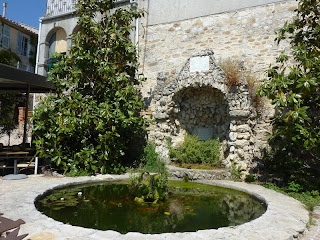Whatever our question was, Eva would begin her answer with, "It's complicated." When we asked, "What is the capital of Provence?", we received a history of the area, starting with the Greeks and progressing to the Romans. When Eva finished, she remarked, "Is that clear?" No one knew what the capital was but we decided not to ask again. We adored Eva's accent so much that we really did not care what she said but liked the way she said it. We did read later that Aix-en-Provence was the capital of the Roman province and later of the independent state of Provence.
It always seems to surprise those from Florida that one side of the highway can be coastal beaches while the other side is mountains. Eva explained that the color of the mountain changes with the seasons and the weather. "It's fantastic! In a thunderstorm, the mountain is black." It almost made us wish for rain on a glorious, sun-filled day.
Our first stop was Aix, which Eva told us had a very expensive cost of living--Aix is three times pricier that Toulon while Monte Carlo is twice as expensive as Aix. The prices, even if they had been in dollars rather than euros, seemed inflated. And the dollar was at an all-time low against the euro. In the center of the fountain are three ladies representing justice, art and architecture. In the summer, the temperatures can soar to 120 degrees while the winter is cold and snowy. The city sponsors an arts and crafts show the weekend of the month with an incredible number of vendors based on the number of spaces that had been designated.
Thanks to enlightened rulers, like the Good King Rene, Provence and its capital Aix has had a phenomenal flourishing culture since the the medieval centuries. Rene married Queen Jane and built beautiful palaces for her. Paul Cezanne's parents had a house in Aix where his father was a hat maker. Like every village, Aix had a marketplace to the residents to buy food. What a delightful way to buy fresh fruits, vegetables, meats, spices and almost anything else that you would like. Every village of any size sponsors a market. In a small town, it may only be open once a week while in a larger town like Aix, the residents and visitors can enjoy the sights and aromas every day.
Eva warned us not to ask for a room at the Hotel de Vilee, a former palazzo built in the 17th century for a local count, because it now served as City Hall. We stood in the plaza trying to soak in the ambiance and whom did we see but passengers from a ship's tour eating lunch. Also, we did not want to breathe too deeply because something in the air was causing people to sneeze and cough with tissues seen everywhere. On the plus side, we dined on the most delicious pizza we have ever had, purchased from a sidewalk vendor. We knew we were in France because wine was less expensive than soda. Eva wanted to show us the Cathedral Saint-Sauveur, an 11th century church with a clock tower, but a funeral was ending. Most of the mourners wore black slacks and top, even the women. During the French Revolution, many of the churches had been burned down. (We need to research this.)
The next charming village that we visited was (can anyone supply the name???), a small feudal village in a provincial, picturesque setting. We entered the village through two fortified gates. Then we drove on to Cassis, where everyone goes to the beach in the summer and imbibes in La Blanc de Cassis, the region's famous white wine that is dry and a little sparkling. After the French Revolution, the castle in the city was abandoned because it required money to maintain it. The castle was eventually sold for one French franc with the provision that the new owner would maintain it.
As we searched for a parking space, Eva explained with a definite tone of exasperation, "I hate Cassis! You can never find a parking space!" We never did. We walked over to the beach while Eva stayed with the van. The beach was more sand than pebbles. The nationality of the tourists changes with the school holidays. While Cassis used to attract many English visitors, the English had not shown up in great numbers in the last two years due to the economy. In August, the French on their summer holiday populated the beach. Eva then drove us up a winding, narrow road for a spectacular overview of Cassis, where the wind can blow up to 100 mph with pine trees tilted sideways to attest to the velocity. Looking down on the terraced vineyards was amazing.
The next stop was Le Castillet, named after the little castle built in the 14th century, which serves today as the town's city hall. From the end of World War II to 1987, the village was abandoned. Then a wealthy lady from England purchased a house there, and the village was revived. We climbed several sets of steps to enter the village and be rewarded with an outstanding overview of vineyards. The beautiful and sharming Saint Anne du Castillet from the 11th century is popular for weddings. What a wonderful setting for the couple's romantic day!
Our last stop was Vins De Bardol for a wine tasting, where we tasted the most tempting roses ever. Bastide de la Ciseletle had absolutely the perfect pink color. We learned that the sooner the grapes are pressed, the lighter the color of wine. Ken, who came into the day with a negative opinion of France, decided to reconsider the country with beautiful weather, beautiful wine and beautiful women. The rest of our little group agreed that the scenery and weather along the French Riviera reminded us of California.











No comments:
Post a Comment